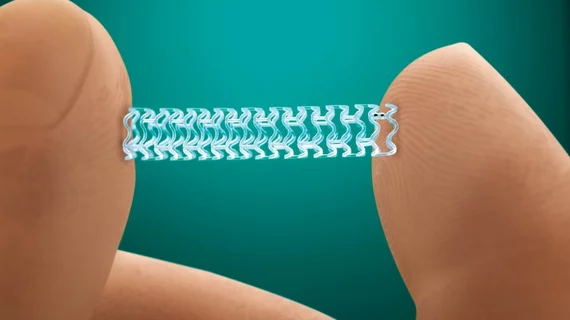Five-year results of the ABSORB III trial suggest that, while target lesion failure and scaffold thrombosis have remained apparent in patients implanted with bioresorbable vascular scaffolds (BVS), the poor outcomes associated with BVS seemed to subside after three years, when the stents had completely dissolved.
Realizing the concept of the BVS in clinical practice has been a journey fraught with worry and doubt, starting with discouraging study results first presented at TCT 2017 in Denver. One-year results of the ABSORB III study were weak—Abbott’s Absorb BVS proved noninferior to the company’s everolimus-eluting Xience stent (EES) in a primary endpoint of one-year target lesion failure (TLF)—but study author Stephen G. Ellis, MD, called the trial’s three-year results “a major damper” on the field.
“I think we’ve learned quite a bit about technique,” he said at TCT. His team had reported that 13.4% of BVS recipients had met the study’s device-oriented primary endpoint three years after implantation, compared to 10.4% of EES patients. Between one and three years after treatment, TLF occurred in 7% and 6% of BVS and EES patients, respectively, and BVS recipients also recorded higher rates of target vessel failure, death, MI, target vessel myocardial infarction (TVMI) and revascularization.
Ellis and colleagues said the increased rate of adverse events in patients implanted with BVS were primarily driven by an increase in MIs related to device thrombosis.
Though Abbott opted to pull all Absorb BVS stents from the commercial market in September of 2017, citing low sales, Ellis and his colleagues pushed forward with their research. The Absorb BVS was designed to fully dissolve within a patient’s body around three years after implantation, making it an effective tool for early drug delivery and mechanical support while circumventing some of the negative properties of bare-metal stents.
Considering that, post-three-year BVS results should demonstrate some improvement compared to pre-three-year results—and they did. Ellis et al.’s five-year findings, presented at this year’s TCT symposium in San Francisco, showed that while rates of TLF, TVMI and scaffold thrombosis increased through five-year follow-up with BVS compared to EES, between three and five years patients saw reductions in the relative hazards of BVS.
In particular, compared to the zero-to-three-year time period, between three and five years the hazard ratio (HR) for TLF dropped from 1.35 to 0.82, and the HR for stent thrombosis fell from 3.23 to 0.26.
“The major finding is that while adverse outcomes through five years were inferior with the first-generation BVS compared with the contemporary EES, device-oriented events varied in both their annualized and relative frequency beyond the three-year time point,” Ellis et al. wrote in Circulation, where they published ABSORB III results Sept. 25. “Before this three-year landmark period adverse event rates were increased with BVS compared with EES, with the curves diverging over time. After the three-year time point the excess risk with BVS was no longer apparent, and if anything, the point estimate between the two randomized devices favored the bioresorbable scaffold.”
The authors noted a downward trend in annualized event rates for BVS after the three-year mark that wasn’t replicated in EES patients. They said the ongoing annual event hazard after EES implantation might be explained by the continued presence of a metal skeleton, which is a nonissue with the BVS.
There was no difference in clinical effectiveness between the two devices at five years, but adverse event rates relating to device safety—including TVMI and device thrombosis—were increased with BVS compared with EES. Still, the excess risk period for BVS did seem to end at three years, coincident with complete scaffold resorption.

